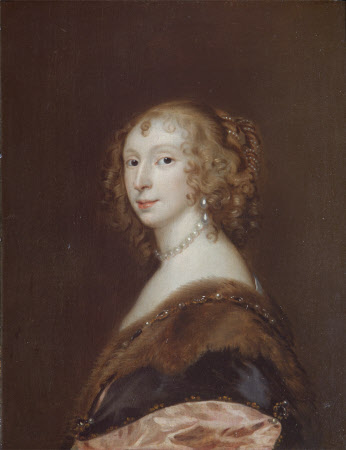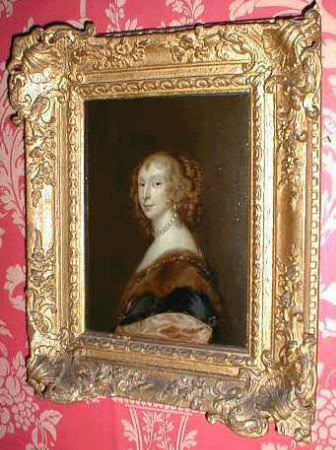Mary Hill, Lady Killigrew (1615-1686)
after Sir Anthony Van Dyck (Antwerp 1599 - London 1641)
Category
Art / Oil paintings
Date
1670 - 1699
Materials
Oil on canvas
Measurements
255 x 200 mm
Place of origin
England
Order this imageCollection
Belton House, Lincolnshire
NT 436019
Summary
Oil painting on canvas, Mary Hill, Lady Killigrew (1615 - 1686), after Sir Anthony Van Dyck (Antwerp 1599 - London 1641). A half-length portrait of a young woman facing left but with head turned towards the spectator, wearing a blue dress with fur stole attached to the bodice and a pearl necklace. The sitter was the daughter of John Hill of Honiley in Warwickshire. She married in 1626, Sir William Killigrew, MP (1606 - 1695), playwright and courtier, one of seven sons and five daughters of Sir Robert Killigrew (1580 - 1633) and Mary Wodehouse. She had three sons and a daughter who married Sir Francis Clinton, Earl of Lincoln. Mary was a dresser to Queens Henrietta Maria and Catherine of Braganza, and this would certainly explain her appearance in the Wilton portrait with the Countess of Morton (if indeed it is she) who was a close aide to Henrietta Maria. Her husband Sir William was knighted in 1626, taking a Grand Tour of Europe before being elected MP for Newport and Penryn in Cornwall, and appointed Governor of Pendennis Castle and Falmouth Haven. He was made gentleman usher to Charles I, studying with him at Oxford and commanding one of the troops of horses that guarded the king during the civil war.This is a partial copy after a second portrait of Mary Hill, Lady Killigrew by Van Dyck; the first original of 1638 is in Tate Britain with its pair of her husband. Here her face is in semi-profile and the prime version of this at Blenheim Palace, Oxfordshire and another at Wilton House, Wiltshire has her seated in a double friendship portrait alongside a lady traditionally but probably wrongly identified as Anne Villiers, Countess of Morton, later Lady Dalkeith (died 1654) with a landscape backdrop. There is a similar pair of Countess of Morton and Lady Anna Kirk in the Hermitage, St Petersburg.
Provenance
Purchased with a grant from the National Heritage Memorial Fund (NHMF) from Edward John Peregrine Cust, 7th Baron Brownlow, C. St J. (b.1936) in 1984
Credit line
Belton House, The Brownlow Collection (acquired with the help of the National Heritage Memorial Fund by the National Trust in 1984)
Makers and roles
after Sir Anthony Van Dyck (Antwerp 1599 - London 1641), publisher previously catalogued as attributed to Edmund Ashfield (fl. c.1669 - c.1700), publisher

